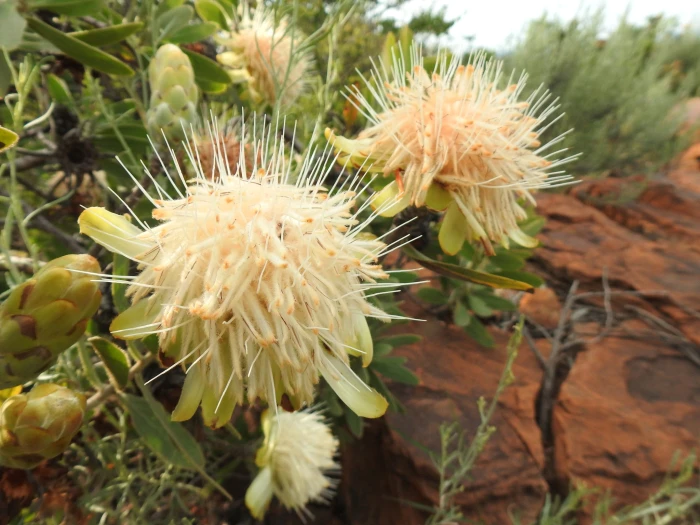Cluster-Head Protea
(Protea welwitschii)
Cluster-Head Protea (Protea welwitschii)
/
/

Matthew Fainman
CC BY 4.0
Image By:
Matthew Fainman
Recorded By:
Copyright:
CC BY 4.0
Copyright Notice:
Photo by: Matthew Fainman | License Type: CC BY 4.0 | License URL: http://creativecommons.org/licenses/by/4.0/ | Rights Holder: Matthew Fainman | Publisher: iNaturalist | Date Created: 2021-01-05T16:37:58-08:00 |























Estimated Native Range
Climate Requirements for Sanger, California
| This Plant | Your Site | Plant Suitability for Your Location | ||
|---|---|---|---|---|
| • Precipitation | 11" - 73" | 13" | Your precipitation may be insufficient for this plant. Irrigate N" / year. | Irrigate N" / year |
| • High Temp. | 67°F - 92°F | 98°F | Your summers may be too hot for this plant. | Too hot |
| • Low Temp. | 31°F - 67°F | 36°F | Your winter temperatures are normal for this plant | Excellent |
This plant should grow well at your location with about N inches per year (Y minutes per month) of irrigation.
Summary
Protea welwitschii, commonly known as cluster-head protea or dwarf savanna sugarbush, is a spreading shrub or small tree native to the bushveld and grasslands of southeastern Africa, including countries like Zimbabwe and Mozambique. It typically grows up to 9.8 feet (3 meters) tall and features elliptic to oblanceolate bluish-green leaves. The plant is notable for its large, showy flower heads that are white to pale cream or brown, blooming from December to May. These flowers are pollinated by beetles and birds, and the species has adapted to survive periodic wildfires, resprouting after being burnt.
Protea welwitschii is valued for its striking flowers and resilience to fire, making it a unique addition to gardens in regions with similar climates. It is often used in ornamental plantings and as a feature in xeriscaping due to its low water requirements. The plant prefers well-drained soils and full sun exposure. While it is generally low-maintenance, it can be susceptible to root rot if overwatered or planted in poorly drained soils. It is also sensitive to frost, which should be considered when planting in cooler climates.CC BY-SA 4.0
Protea welwitschii is valued for its striking flowers and resilience to fire, making it a unique addition to gardens in regions with similar climates. It is often used in ornamental plantings and as a feature in xeriscaping due to its low water requirements. The plant prefers well-drained soils and full sun exposure. While it is generally low-maintenance, it can be susceptible to root rot if overwatered or planted in poorly drained soils. It is also sensitive to frost, which should be considered when planting in cooler climates.CC BY-SA 4.0
Plant Description
- Plant Type: Shrub
- Height: 6-10 feet
- Width: 6-10 feet
- Growth Rate: Slow
- Flower Color: Cream, White
- Flowering Season: Winter, Spring
- Leaf Retention: Evergreen
Growth Requirements
- Sun: Full Sun
- Water: Low
- Drainage: Medium, Fast
Common Uses
Bird Garden, Drought Tolerant, Low Maintenance, Showy Flowers
Natural Habitat
Native to the bushveld and grasslands of southeastern Africa, including Zimbabwe and Mozambique
Other Names
Common Names: Welwitsch’s Sugarbush, Cluster-Head Protea, Cluster-Head Sugarbush, Honey-Scented Protea, Rusty Velvet Protea, White Sugar-Bush, Welwitsch’s Protea
Scientific Names: Protea welwitschii, Leucadendron leucoblepharis, Leucadendron welwitschii, Protea abyssinica subsp. adolphi-friderici, Protea abyssinica subsp. brevifolia, Protea abyssinica var. adolphi-friderici, Protea abyssinica var. brevifolia, Protea congensis, Protea eickii
GBIF Accepted Name: Protea welwitschii